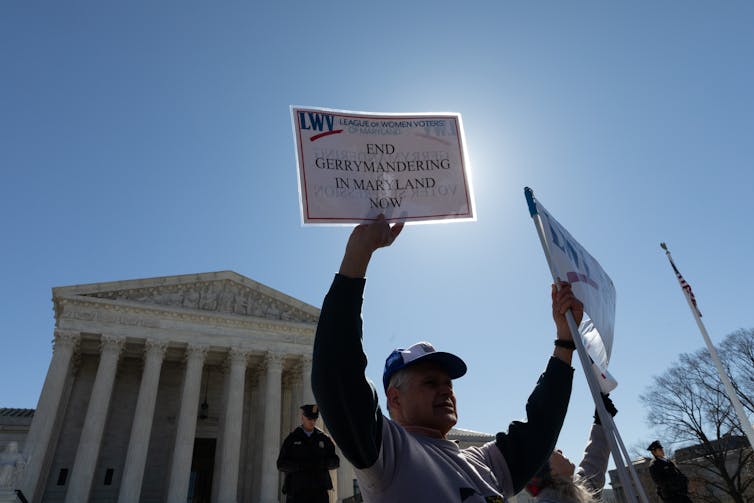When it comes to explaining elections in Congress, gerrymandering is overrated
A loud chorus of Democrats – and some Republicans, too – has for years claimed gerrymandering is costing their party seats in Congress. Is it true?

Over the past decade, a consistent refrain in discussions of politics has been that partisan gerrymandering – the drawing of congressional district lines to disproportionately advantage one party over the other – is unfair and distorts the balance of power in Congress.
Democrats in particular have complained that the process advantages Republicans. Republicans have been quick to blame Democrats for the same thing in states such as Maryland.
But ultimately, the parties’ efforts to gain a seat advantage in the most recent round of redistricting ended up mostly in a wash – and 2022’s razor-thin midterm election results reflected this.
As a political scientist who studies Congress, elections and political representation, I know that redistricting is both more complex and less nefariously partisan than many commentators give it credit for. The truth is that gerrymandering has always been overrated as an explanation of election outcomes in Congress.
Let’s run through some of the reasons.

Does gerrymandering skew election outcomes?
The Constitution requires that every 10 years, following the decennial census, states redraw the geographic boundaries of congressional districts. The purpose is largely to make sure the districts are as equal as possible based on population.
Most states rely on their state legislatures to draw these lines. Critics of this process charge that in many cases, this results in gerrymandering: the drawing of districts specifically to maximize the number of seats for the party that controls the legislature.
In many individual states, partisan majorities in state legislatures have drawn boundaries that result in congressional delegations that don’t reflect the statewide vote. In 2021, for example, Republicans in South Carolina drew districts that handed their party six out of the delegation’s seven seats in Congress, despite the party’s winning only 56% of the vote in 2020’s presidential election.
Democrats in Illinois, meanwhile, won 59% of the presidential vote in 2020; but after the 2022 midterm elections, they occupy 82% of the state’s congressional delegation, or 14 out of 17 seats, thanks to the heavily Democratic state Legislature’s redistricting.
The fact that both parties excel at gerrymandering meant that their efforts before the 2022 midterms essentially canceled each other out. As a result, the balance of seats in the new Congress largely matches the national political climate in the midterms. In 2022, Republicans won 51% of House seats, and 51% of the nationwide popular vote for Congress.
These numbers present a problem for gerrymandering critics, particularly those blaming it for the Democrats’ current minority status in Congress. If gerrymandering were significantly advantaging one or the other party, these numbers would not match up.
But this alignment between seats and votes isn’t a new trend. In the three most recent Congresses, the balance of congressional seats between the two parties is nearly identical to the percentage of the vote each party received nationwide in congressional races. In the 2018 midterms, for example, Democrats won 54% of congressional votes nationwide, and ended up with 54% of the seats in the House.
Data I’ve collected for other cycles does show a discrepancy between seats and votes during the Obama years, and it’s probably true that the redistricting process before 2012 cost Democrats a few seats in that decade.
But gerrymandering hasn’t always benefited Republicans: Democrats enjoyed a bigger and more sustained advantage from their district boundaries during the 1970s and 1980s. And if gerrymandering was ever the main cause of Democrats’ seat disadvantage in the House, it’s not today.
Geography matters, just not the way you think
Democrats and their allies have been particularly outspoken in their disparagement of gerrymandering, in some cases using some of the same fatalistic language about elections as former President Donald Trump.
For example, one argument during the Obama years was that gerrymandering made it “impossible” for Democrats to win the House. Sometimes the language mirrored Trump’s — that gerrymandering had “rigged” congressional elections in favor of Republicans.
Aside from the well-demonstrated dangers of casting doubt on the nation’s election systems, the evidence simply doesn’t support this doomsday perspective. Democrats do have major problems with geography, but they run much deeper than unfairly drawn lines.
Over the past 30 years, U.S. counties have consistently become less competitive between the parties in presidential elections.
In 1992, the vast majority of counties were won by slim margins, and thus winnable by either party. Only 1 in 3 counties was won by either party by more than 10 percentage points.
But today, the story is the opposite. Nearly 4 out of every 5 counties in 2020 were won decisively – by 10 points or more – by either Joe Biden or Donald Trump.
The problem for Democrats is that these emerging landslide counties almost exclusively vote for Republicans. The thing about counties, though, is that their boundaries don’t change. This means that the massive geographic advantage Republicans enjoy cannot be blamed solely on gerrymandering.
The real explanation is the geographic sorting of the two parties over the past 30 or more years. Democrats have diminished as a presence in rural counties, particularly in the South and Midwest, while gaining numbers in counties with large cities like Los Angeles, Houston and Chicago.
These latter areas have such large populations that by winning them decisively, Democrats can stay competitive nationally despite Republicans’ more even geographic spread of support across the country.
The data largely indicates that it is this phenomenon, not gerrymandering, that is responsible for Democratic electoral underperformance. The clustering of Democratic votes in big cities makes it more difficult for any entity – including courts and nonpartisan commissions – to draw district lines that get Democrats the most possible seats in Congress. Because Democrats live in denser, more tightly packed places, they can’t distribute their votes as efficiently among geographic districts throughout a state.
Meanwhile, because Republican support is more evenly distributed geographically, there are more and better options for them to win lots of districts, rather than just lots of votes. Put simply, because of where they tend to live, Republicans are wasting fewer of their votes than Democrats.
Gerrymandering is still a problem
None of this means that partisan gerrymandering is not happening, or that efforts shouldn’t be made to fix it.
If both parties are gerrymandering so effectively that they cancel out each other’s gains, this has major implications for political institutions and culture even if they aren’t reflected in the national balance of power.
Gerrymandering has been increasingly the subject of court challenges, further bringing politics into the supposedly nonpolitical U.S. judicial system.
It also has tangible effects on regular Americans. My own research shows that changing district lines can disorient voters and reduce turnout. It could also cut into voters’ sense that their votes make a difference.
Democrats from South Carolina and Republicans from Illinois, would, I believe, feel better represented if they could see delegations that more accurately reflected their state’s electorate.
Additionally, partisan gerrymandering often means disregarding important local city and county boundaries, as well as local cultures, neighborhoods and industries – what political scientists call “communities of interest” – that have little to do with partisanship but mean a lot to everyday people.
Charles R. Hunt does not work for, consult, own shares in or receive funding from any company or organization that would benefit from this article, and has disclosed no relevant affiliations beyond their academic appointment.
Read These Next
From truce in the trenches to cocktails at the consulate: How Christmas diplomacy seeks to exploit s
World leaders like to talk up peace at Christmastime. But alongside the tales of seasonal breaks in…
As DOJ begins to release Epstein files, his many victims deserve more attention than the powerful me
Powerful men connected to Jeffrey Epstein are named, dissected and speculated about. The survivors,…
People are getting their news from AI – and it’s altering their views
Even when information is factually accurate, how it’s presented can introduce subtle biases. As large…






